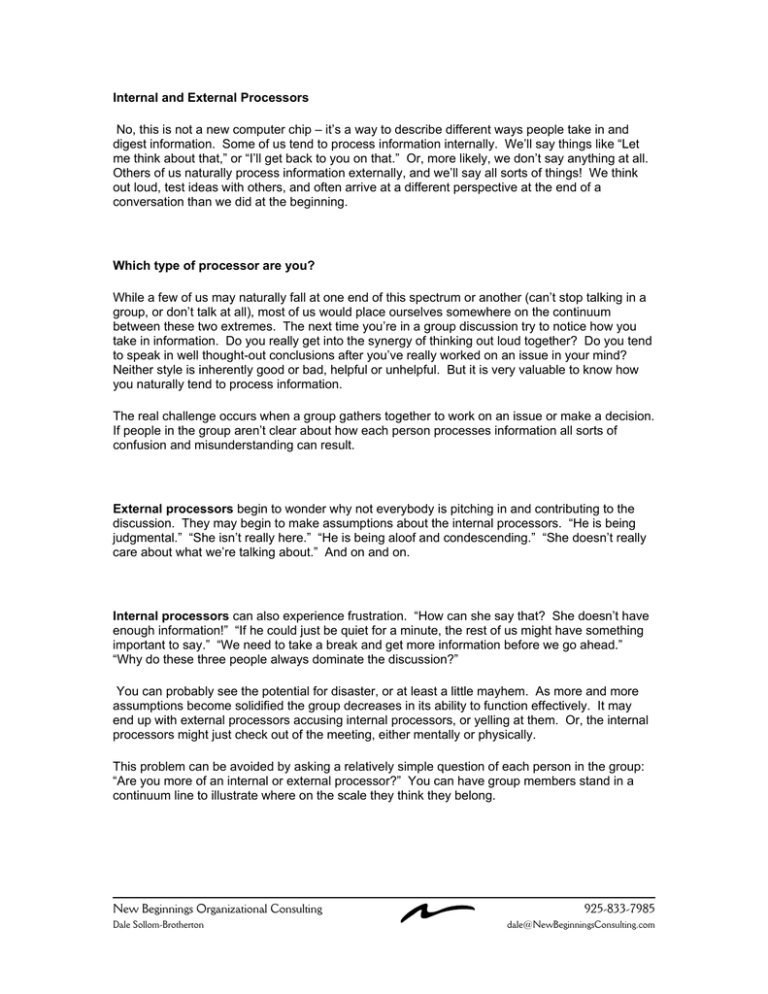
Internal and External Processors
No, this is not a new computer chip – it’s a way to describe different ways people take in and
digest information. Some of us tend to process information internally. We’ll say things like “Let
me think about that,” or “I’ll get back to you on that.” Or, more likely, we don’t say anything at all.
Others of us naturally process information externally, and we’ll say all sorts of things! We think
out loud, test ideas with others, and often arrive at a different perspective at the end of a
conversation than we did at the beginning.
Which type of processor are you?
While a few of us may naturally fall at one end of this spectrum or another (can’t stop talking in a
group, or don’t talk at all), most of us would place ourselves somewhere on the continuum
between these two extremes. The next time you’re in a group discussion try to notice how you
take in information. Do you really get into the synergy of thinking out loud together? Do you tend
to speak in well thought-out conclusions after you’ve really worked on an issue in your mind?
Neither style is inherently good or bad, helpful or unhelpful. But it is very valuable to know how
you naturally tend to process information.
The real challenge occurs when a group gathers together to work on an issue or make a decision.
If people in the group aren’t clear about how each person processes information all sorts of
confusion and misunderstanding can result.
External processors begin to wonder why not everybody is pitching in and contributing to the
discussion. They may begin to make assumptions about the internal processors. “He is being
judgmental.” “She isn’t really here.” “He is being aloof and condescending.” “She doesn’t really
care about what we’re talking about.” And on and on.
Internal processors can also experience frustration. “How can she say that? She doesn’t have
enough information!” “If he could just be quiet for a minute, the rest of us might have something
important to say.” “We need to take a break and get more information before we go ahead.”
“Why do these three people always dominate the discussion?”
You can probably see the potential for disaster, or at least a little mayhem. As more and more
assumptions become solidified the group decreases in its ability to function effectively. It may
end up with external processors accusing internal processors, or yelling at them. Or, the internal
processors might just check out of the meeting, either mentally or physically.
This problem can be avoided by asking a relatively simple question of each person in the group:
“Are you more of an internal or external processor?” You can have group members stand in a
continuum line to illustrate where on the scale they think they belong.
New Beginnings Organizational Consulting
Dale Sollom-Brotherton
925-833-7985
dale@NewBeginningsConsulting.com
Once this is clear here are some tips.
For internal processors:
-Remember to speak up more often, even if your thought is not fully formed. Just say so!
-Recognize that the external processors are more likely to think out loud; they’re not necessarily
making declarative statements or issuing conclusions.
-Tell the group when you’re on overload. Ask for a break, or point out the need for more
information. But make sure the break isn’t too long and doesn’t unduly impede the group.
-Ask the group for feedback on your contributions. Many groups highly value a quiet member
who can then make a good clarifying and integrating statement towards the end of the discussion.
You may (or may not) be that person.
For external processors:
-Try to notice if you’re speaking a lot more than others. If you are, then pipe down! If you don’t
know, ask the group, “Am I talking too much?”
-Invite the quieter members of the group to contribute their input. Just ask, “What do you think,
Doug?”
-Recognize that silence from internal processors more than likely means they are thinking about
something that was said in the group. Don’t make other assumptions about their quietness
unless you have data.
-Clarify if this is brainstorming or decision-making. This helps the internal processors understand
how they might contribute most helpfully.
Knowing your information processing style is a valuable self-awareness tool. Knowing the styles
of your entire work group is a great way to boost your group’s effectiveness and satisfaction.
© 2002 New Beginnings Consulting. All rights reserved.
New Beginnings Organizational Consulting
Dale Sollom-Brotherton
925-833-7985
dale@NewBeginningsConsulting.com




